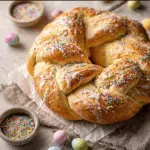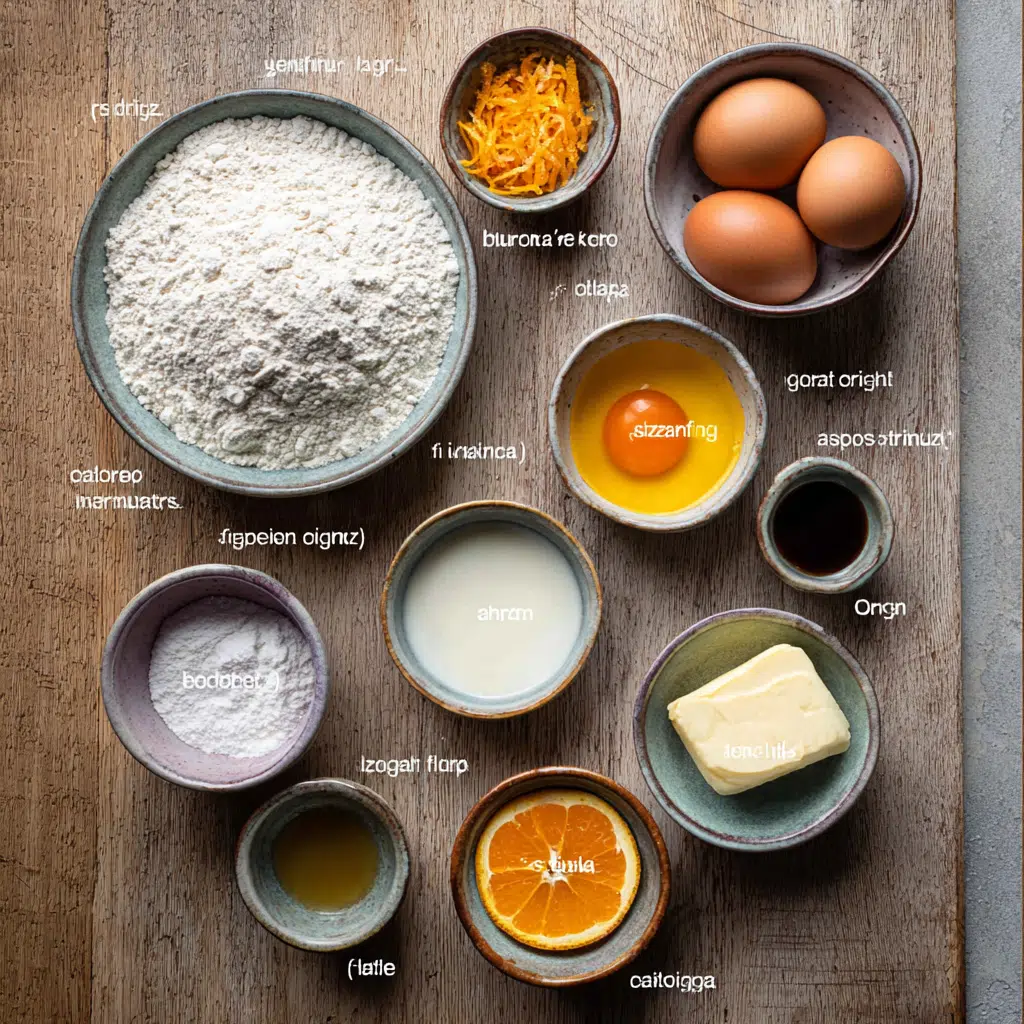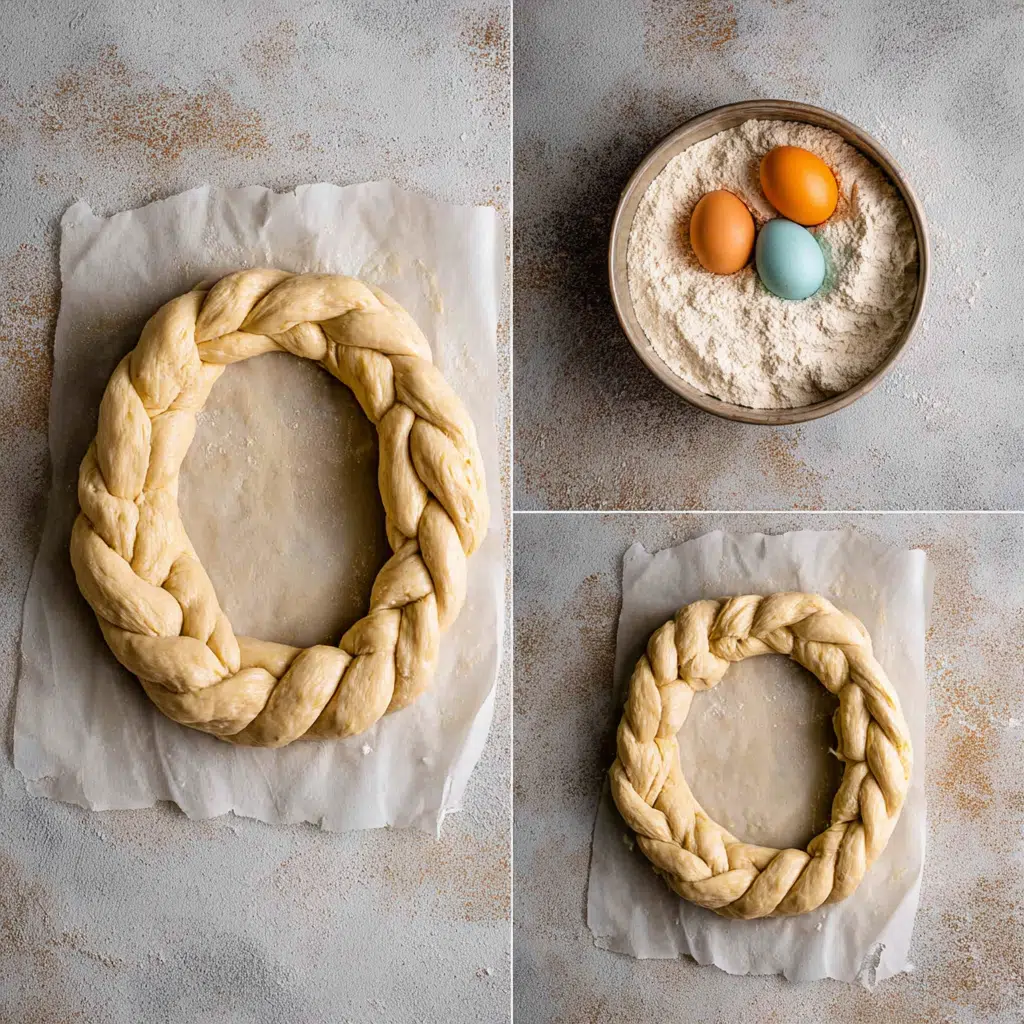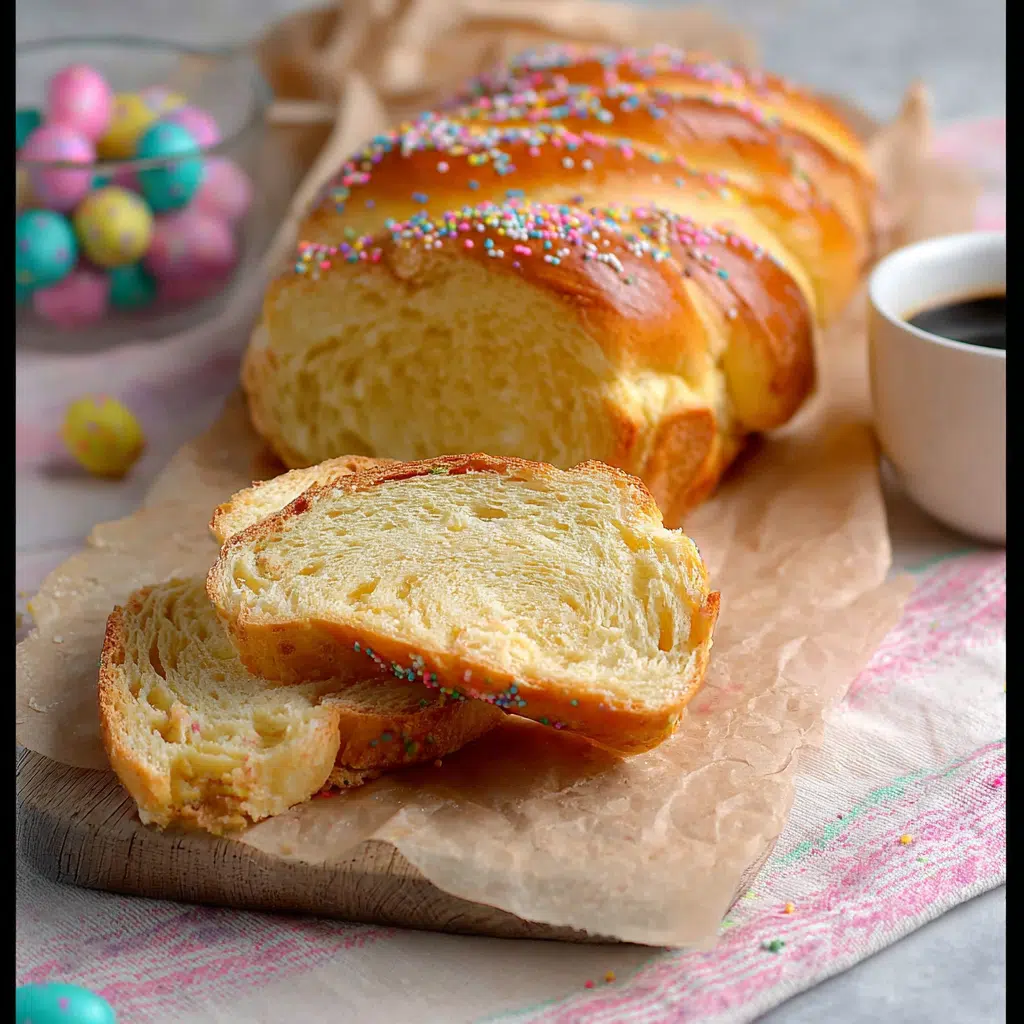Easter mornings in Mendocino smell like orange zest and melted sugar. In my tiny coastal kitchen, I remember my first Italian Easter Bread—shaped like a wreath, its vibrant eggs peeking through a golden crust. It was a recipe I stumbled into while learning to impress with carbs (spoiler: it worked better than that first boule ever did). This soft, citrusy bread dotted with sprinkles and topped with a simple glaze carries more than tradition—it carries joy. In this article, I’ll walk you through the flavors, meanings, and baking steps behind this festive classic.
Let’s dive into the story behind Italian Easter Bread.
The Joyful Origins of Italian Easter Bread
A sweet tradition tied to family and faith
Italian Easter Bread, known traditionally as Pane di Pasqua, is more than just a treat—it’s a symbol of celebration. Each region in Italy has its own twist on the recipe, but the common thread is sweet, enriched dough baked into a circular or braided shape with colorful eggs nestled inside. Growing up, I wasn’t Italian, but I was fascinated by the ritual of baking something so symbolic. The braided design represents the circle of life, and the eggs are tied to rebirth—Easter’s deeper meaning. When I baked my first version, the whole kitchen smelled like celebration.
Many traditional loaves are flavored with orange, lemon, or anise, much like what I use in my version. The citrus brightens the rich dough, while the anise oil adds a subtle licorice-like aroma that always reminds me of Easter sunrise services. In our bakery, “Marlene & Crumb,” we love riffing off these roots—sometimes shaping the dough into small nests for kids or dyeing the eggs with natural ingredients like beets and turmeric.
You’ll find this bread sitting proudly beside lamb roasts and artichokes at many Easter feasts in Italy. It’s as symbolic as it is delicious.
Looking for other sourdough explorations? You might enjoy reading about Clever Carrot Sourdough or this delightful Garlic Sourdough Toast.
The role of eggs and the braided wreath shape
You may be wondering: why are there eggs in this bread? In traditional Catholic symbolism, the egg represents resurrection and new life. By baking them into the dough—uncooked and dyed—the bread itself becomes a centerpiece of hope. Some families bake one egg per child into the loaf, while others craft individual rings. The wreath shape, often braided, speaks to unity, continuity, and the eternal cycle of life and renewal.
When I teach this recipe at Easter workshops, I always encourage bakers to make it their own. Use boiled eggs, raw eggs that bake as the bread rises, or even chocolate eggs if you’re leaning toward the sweeter side. Either way, this bread becomes a celebration you can taste—warm, rich, and filled with meaning.
Don’t miss my take on Chocolate Chip Croissant Sourdough Bread if you enjoy festive fusion baking.
Print
Italian Easter Bread – Stunning Spring Recipe With Meaning (Easy)
- Total Time: 210
- Yield: 2 large wreaths 1x
- Diet: Vegetarian
Description
Italian Easter Bread is a sweet, citrusy, braided bread made with eggs, orange zest, and anise oil. It’s a festive centerpiece for Easter brunch, glazed and topped with colorful sprinkles.
Ingredients
For the Dough
8 cups (1040 g) all-purpose flour
1½ cups (360 ml) whole milk
½ cup (99 g) granulated sugar
2 oranges, zested & juiced
4½ teaspoons (2 envelopes) active dry yeast
1 cup (227 g) margarine, melted
8 eggs
1 teaspoon salt
½ teaspoon anise oil
2 tablespoons unsalted butter, melted (for brushing)
For the Glaze
2 cups (227 g) powdered sugar
¼ cup (60 ml) whole milk
Sprinkles, if desired
Instructions
1. Warm milk and add yeast with 1 tsp sugar. Let sit until foamy.
2. In a large bowl, mix flour, remaining sugar, salt, zest, and anise oil.
3. Add yeast mixture, melted margarine, and eggs. Mix to form sticky dough.
4. Knead 8–10 minutes until smooth. Let rise until doubled.
5. Divide dough into 3 ropes. Braid and form into wreath. Place eggs in braid.
6. Brush with melted butter. Let rise again for 30 minutes.
7. Bake at 350°F (175°C) for 35–40 minutes.
8. Cool, then drizzle with glaze and add sprinkles.
Notes
Use raw dyed eggs if baking into the dough, or hard-boiled if preferred.
This bread makes beautiful gifts and also freezes well.
You can shape into mini wreaths or braided loaves.
- Prep Time: 30
- Cook Time: 40
- Category: Bread
- Method: Baking
- Cuisine: Italian
Nutrition
- Serving Size: 1 slice
- Calories: 290
- Sugar: 17g
- Sodium: 150mg
- Fat: 9g
- Saturated Fat: 4g
- Unsaturated Fat: 3g
- Trans Fat: 0g
- Carbohydrates: 43g
- Fiber: 1g
- Protein: 6g
- Cholesterol: 95mg
Keywords: Italian Easter Bread, Pane di Pasqua, Easter recipes
How to Make Italian Easter Bread – From Dough to Braids
What goes into authentic Italian Easter Bread
The secret to perfect Italian Easter Bread lies in the richness of its dough. It’s a festive, fragrant bread made with eggs, orange zest, and a touch of anise. To get started, here’s what you’ll need:
- 8 cups all-purpose flour
- 1½ cups whole milk, warmed
- ½ cup granulated sugar
- 2 oranges, both zested and juiced
- 4½ teaspoons active dry yeast
- 1 cup melted margarine
- 8 eggs
- 1 teaspoon salt
- ½ teaspoon anise oil
- 2 tablespoons melted butter (for brushing)
Italian Easter Bread isn’t just about flavor—it’s about tradition. The anise and citrus evoke springtime and rebirth, while the eggs symbolize new life. This combination of ingredients creates a tender, almost brioche-like bread that feels festive and indulgent.
When I prepare Italian Easter Bread at the bakery, the scent of orange and anise always fills the kitchen. It’s one of the most comforting, nostalgic smells I know.
If you’re experimenting with enriched doughs, I also recommend this sourdough health guide and the versatile Clever Carrot Sourdough for more ideas.

Mixing, kneading, and the perfect rise
To begin your Italian Easter Bread, activate the yeast. Warm the milk (not hot!) and stir in a spoonful of sugar and the yeast. Let it sit for 10 minutes until it’s foamy.
In a large bowl, combine flour, the rest of the sugar, orange zest, salt, and anise oil. Pour in the yeast mixture, eggs, and melted margarine. Mix until a sticky dough forms. Then knead it—by hand or with a dough hook—for about 8–10 minutes until the dough is elastic and smooth.
This dough needs to rise until doubled, usually 1½ to 2 hours. Keep it in a warm place. I like to place my bowl inside a turned-off oven with just the light on. While waiting, you can dye your eggs for decoration or prep your glaze ingredients.
Italian Easter Bread is known for its braid. Once the dough has risen, divide it into three ropes. Braid loosely, forming either a circle or straight loaf. Tuck dyed eggs into the folds—they’ll bake in the oven as part of the bread.
Sprinkle tips? For added festivity, press colorful sprinkles gently into the dough before baking. If you want to explore different enrichments, the Izzio Sourdough Bread and Chocolate Chip Croissant Sourdough offer creative inspiration.
In the end, your dough should feel like tradition in your hands—soft, pliable, and fragrant. That’s the magic of Italian Easter Bread.
Baking and Decorating Italian Easter Bread – Glaze, Eggs & Sprinkles
How to glaze and bake Italian Easter Bread perfectly
After shaping and braiding your Italian Easter Bread, it’s time to bring it to life in the oven. But first—those iconic dyed eggs. Traditionally, the eggs are raw and nestled into the dough before baking. They’ll cook in the oven alongside the bread. If you prefer, you can use hard-boiled eggs for safety and color control.
Before placing your wreath or loaf in the oven, brush it gently with melted butter. This step gives the Italian Easter Bread a glossy, golden finish. Bake at 350°F (175°C) for about 35–40 minutes, or until the crust turns a deep amber color and the loaf sounds hollow when tapped.
You’ll know it’s done when your kitchen smells like Easter morning. As the bread cools, it’s time to prepare the glaze:
- 2 cups powdered sugar
- ¼ cup whole milk
Whisk together until smooth. Once your Italian Easter Bread has cooled to room temperature, drizzle the glaze generously over the top. Finish with sprinkles while the glaze is still wet, so they stick. I like to use pastel-colored sprinkles to match the mood of spring. My daughter calls them “Easter confetti.”
If your glaze drips off the sides, don’t worry—that’s part of the charm. The glaze adds sweetness and seals in the moisture, keeping the Italian Easter Bread tender for days.
For more baking tools that make shaping easier, explore my write-up on the best toaster for sourdough bread, or check out how Garlic Sourdough Toast pairs with savory loaves.
Making it your own: customization and variations
Italian Easter Bread is beautifully adaptable. Here are a few fun ways you can personalize it:
- Mini wreaths: Shape smaller braided rounds, each with a single dyed egg. These make lovely Easter brunch table settings.
- No egg version: Skip the eggs and let the braids shine with glaze and sprinkles only.
- Extra citrus: Add lemon zest for a brighter flavor profile.
- Anise-free version: If you’re not a fan of anise, substitute with vanilla or almond extract.
In our Easter bake-alongs at “Marlene & Crumb,” kids love decorating their own mini Italian Easter Bread loaves. We provide naturally dyed eggs and a rainbow of sprinkles—it becomes edible art and a hands-on memory.
And while this bread leans sweet, it’s not overly sugary. You can enjoy it with a bit of jam, or lightly toasted with butter. Speaking of creativity, you might love how we pushed the boundary with our Croissant Sourdough Bread—it’s a hybrid dream.
The final bread? Light, fragrant, festive. Whether you serve it at Easter brunch or gift it to neighbors, Italian Easter Bread never fails to delight.

Serving, Storing, and Sharing Italian Easter Bread
How to serve Italian Easter Bread like a tradition
Once your Italian Easter Bread is baked, glazed, and sprinkled, the only thing left is to gather loved ones and enjoy it. I like to place it in the center of the Easter brunch table—wreath-style with dyed eggs intact. It’s more than a centerpiece. It’s a symbol. In Italy, this bread is typically sliced and served with coffee or tea in the morning or alongside savory dishes during Easter lunch.
Because Italian Easter Bread has a mild sweetness, it pairs beautifully with whipped butter, fruit preserves, or even mascarpone cheese. Some folks like to toast their slices lightly, giving them a crisp edge and warm center. Others serve it just as it is—soft and fresh, straight from the cooling rack.
I’ve also seen hosts add personal touches, like weaving a ribbon through the braid or placing a candle in the center of the wreath. It makes a beautiful edible centerpiece. If you’ve ever enjoyed the buttery richness of a Chocolate Chip Croissant Sourdough Bread, then you’ll recognize the similar tenderness in this Italian delight.
Don’t forget, it also makes a thoughtful gift. Wrap a loaf in parchment, tie it with twine, and add a handwritten note. It’s tradition with a personal twist.
For more ideas on how to enjoy bread as part of a celebration, you might enjoy reading about the Sourdough Express Fairbanks AK, where bread culture meets community.
Storing leftovers and making the most of every slice
Italian Easter Bread stays fresh for 3–4 days when stored in an airtight container at room temperature. After that, you can freeze it by wrapping slices in plastic wrap and placing them in a freezer bag. To thaw, just let it sit at room temp for 30–60 minutes, or toast it lightly for instant joy.
I’ve even made French toast from leftover slices—it’s divine with maple syrup and fresh berries. The citrus and anise peek through the custard just enough to make it feel special.
If your bread starts to go stale, don’t toss it. Cube it, dry it out, and use it for a sweet bread pudding. At “Marlene & Crumb,” we’ve been known to make a post-Easter brunch out of what we call “Holy Bread Pudding.”
And of course, if you’ve enjoyed this journey, I invite you to explore Sourdough Anchorage for more baking ideas rooted in place, people, and flavor.

FAQs About Italian Easter Bread
What is the name of the Italian Easter Bread?
The traditional name is Pane di Pasqua, meaning “Easter Bread.” It varies by region, but it’s always rich with eggs, citrus, and symbolic shapes.
What is the traditional Italian food for Easter?
Along with Italian Easter Bread, families enjoy roast lamb, artichokes, ricotta pie (pastiera), and often dishes like lasagna or gnocchi depending on regional heritage.
Why is there an egg in Italian Easter Bread?
The egg symbolizes rebirth and renewal, themes central to Easter. It’s often baked into the dough to represent life springing from faith.
What is Easter panettone called?
While not the same as Italian Easter Bread, some refer to Colomba di Pasqua (Easter Dove Bread), which is a sweet, airy bread shaped like a dove and topped with almonds.
Conclusion
Italian Easter Bread is more than a recipe—it’s a ritual. From mixing the sweet dough to braiding with care and watching it rise golden in the oven, every step carries joy. Whether you’re honoring tradition or starting your own, this bread brings people together around flavor and meaning.
So go ahead—mix, braid, bake, and share. I promise your kitchen will smell like a holiday.

